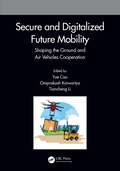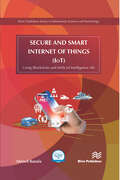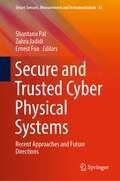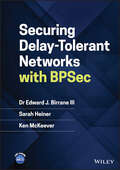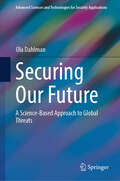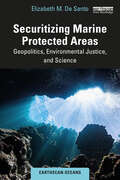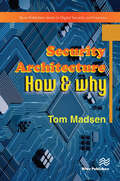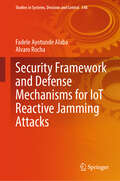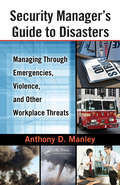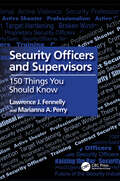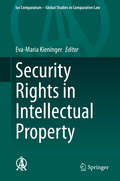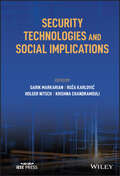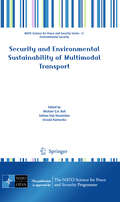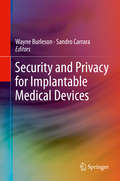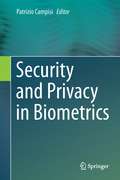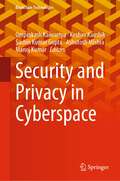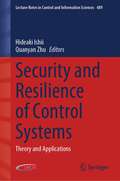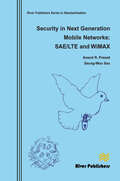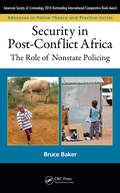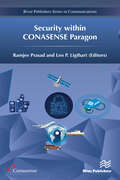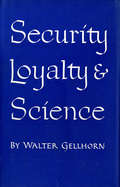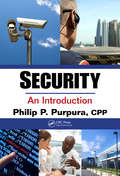- Table View
- List View
Secure IT Systems: 25th Nordic Conference, NordSec 2020, Virtual Event, November 23–24, 2020, Proceedings (Lecture Notes in Computer Science #12556)
by Simin Nadjm-Tehrani Mikael AsplundThis book constitutes the refereed proceedings of the 25th Nordic Conference on Secure IT Systems, NordSec 2020, which was organized by Linköping University, Sweden, and held online during November 23-24, 2020.The 15 papers presented in this volume were carefully reviewed and selected from 45 submissions. They were organized in topical sections named: malware and attacks; formal analysis; applied cryptography; security mechanisms and training; and applications and privacy.
Secure and Digitalized Future Mobility: Shaping the Ground and Air Vehicles Cooperation
by Omprakash Kaiwartya Yue Cao Tiancheng LiThis book discusses the recent advanced technologies in Intelligent Transportation Systems (ITS), with a view on how Unmanned Aerial Vehicles (UAVs) cooperate with future vehicles. ITS technologies aim to achieve traffic efficiency and advance transportation safety and mobility. Known as aircrafts without onboard human operators, UAVs are used across the world for civilian, commercial, as well as military applications. Common deployment include policing and surveillance, product deliveries, aerial photography, agriculture, and drone racing. As the air-ground cooperation enables more diverse usage, this book addresses the holistic aspects of the recent advanced technologies in ITS, including Information and Communication Technologies (ICT), cyber security, and service management from principle and engineering practice aspects. This is achieved by providing in-depth study on several major topics in the fields of telecommunications, transport services, cyber security, and so on. The book will serve as a useful text for transportation, energy, and ICT societies from both academia and industrial sectors. Its broad scope of introductory knowledge, technical reviews, discussions, and technology advances will also benefit potential authors.
Secure and Smart Internet of Things (IoT): Using Blockchain and AI
by Ahmed BanafaBy 2020, experts forecast that up to 28 billion devices will be connected to the Internet, with only one third of them being computers, smartphones, smartwatches, and tablets. The remaining two thirds will be other “devices” – sensors, terminals, household appliances, thermostats, televisions, automobiles, production machinery, urban infrastructure and many other “things”, which traditionally have not been Internet enabled.This “Internet of Things” (IoT) represents a remarkable transformation of the way in which our world will soon interact. Much like the World Wide Web connected computers to networks, and the next evolution mobile devices connected people to the Internet and other people, IoT looks poised to interconnect devices, people, environments, virtual objects and machines in ways that only science fiction writers could have imagined. In a nutshell the Internet of Things (IoT) is the convergence of connecting people, things, data and processes; it is transforming our life, business and everything in between. Secure and Smart IoT explores many aspects of the Internet of Things and explains many of the complicated principles of IoT and the new advancements in IoT including using Fog Computing, AI and Blockchain technology.
Secure and Trusted Cyber Physical Systems: Recent Approaches and Future Directions (Smart Sensors, Measurement and Instrumentation #43)
by Ernest Foo Shantanu Pal Zahra JadidiThis book highlights the latest design and development of security issues and various defences to construct safe, secure and trusted Cyber-Physical Systems (CPS). In addition, the book presents a detailed analysis of the recent approaches to security solutions and future research directions for large-scale CPS, including its various challenges and significant security requirements. Furthermore, the book provides practical guidance on delivering robust, privacy, and trust-aware CPS at scale. Finally, the book presents a holistic insight into IoT technologies, particularly its latest development in strategic applications in mission-critical systems, including large-scale Industrial IoT, Industry 4.0, and Industrial Control Systems. As such, the book offers an essential reference guide about the latest design and development in CPS for students, engineers, designers, and professional developers.
Securing Delay-Tolerant Networks with BPSec
by Edward J. Birrane III Sarah Heiner Ken McKeeverSecuring Delay-Tolerant Networks with BPSec One-stop reference on how to secure a Delay-Tolerant Network (DTN), written by experienced industry insiders Securing Delay-Tolerant Networks with BPSec answers the question, “How can delay-tolerant networks be secured when operating in environments that would otherwise break many of the common security approaches used on the terrestrial Internet today?” The text is composed of three sections: (1) security considerations for delay-tolerant networks, (2) the design, implementation, and customization of the BPSec protocol, and (3) how this protocol can be applied, combined with other security protocols, and deployed in emerging network environments. The text includes pragmatic considerations for deploying BPSec in both regular and delay-tolerant networks. It also features a tutorial on how to achieve several important security outcomes with a combination of security protocols, BPSec included. Overall, it covers best practices for common security functions, clearly showing designers how to prevent network architecture from being over-constrained by traditional security approaches. Written by the lead author and originator of the BPSec protocol specification, Securing Delay-Tolerant Networks (DTNs) with BPSec includes information on: The gap between cryptography and network security, how security requirements constrain network architectures, and why we need something different DTN stressing conditions, covering intermittent connectivity, congested paths, partitioned topologies, limited link state, and multiple administrative controls Securing the terrestrial internet, involving a layered approach to security, the impact of protocol design on security services, and securing the internetworking and transport layers A delay-tolerant security architecture, including desirable properties of a DTN secure protocol, fine-grained security services, and protocol augmentation Securing Delay-Tolerant Networks (DTNs) with BPSec is a one-stop reference on the subject for any professional operationally deploying BP who must use BPSec for its security, including software technical leads, software developers, space flight mission leaders, network operators, and technology and product development leaders in general.
Securing Our Future: A Science-Based Approach to Global Threats (Advanced Sciences and Technologies for Security Applications)
by Ola DahlmanIn an era marked by escalating global crises—climate change, cyber threats, pandemics, and nuclear weapons proliferation—this book introduces a science-based approach to security and global threats. It underscores the necessity of interdisciplinary science and technology to ensure that decisions and actions are grounded in knowledge. This vision seeks to inspire, promote, and facilitate collaboration across all sectors of global society. Building resilient societies and effectively addressing global threats will require substantial resources. Can we afford to save the Earth? Can we afford not to? Four Key Elements: A Science-Based Approach to Security and Global Threats: The book is structured around two key chapters: an opening chapter that outlines this new vision, and a concluding chapter that reflects on how to translate that vision into actionable steps. Evolution of Earth and Society: A review of the development of our planet leading to modern society, with a discussion on global demography and the economy—critical components of global security and resilience. Key Global Communities: An introduction to five global communities—states, cities, the business and scientific communities, and civil society. It examines how each can contribute to building security and assesses their vulnerabilities to various threats. Major Human-Created Threats: A discussion of five large-scale threats created by human activity or arising from human interaction with nature: global warming, natural disasters, biopandemics, nuclear weapons, and cyber threats. This book serves as a call for informed, collaborative action to address the pressing global challenges of our time.
Securitizing Marine Protected Areas: Geopolitics, Environmental Justice, and Science (Earthscan Oceans)
by Elizabeth M. De SantoThis book presents a novel examination of Marine Protected Areas within a security context, bridging science, policy, and geopolitics, and addressing the often-under-emphasized aspect of environmental justice.The book argues that Marine Protected Areas (MPAs) are not only a critical tool for protecting marine biodiversity in a changing climate, but they also play an important role at the intersection of geopolitics and environmental justice, and they provide a case study of environmental governance at the science-policy interface. The book takes an interdisciplinary and critical approach and builds on the author's two decades of experience working in this field. Geopolitically, it explores the ways in which MPAs provide footprints for influence and access to resources far from home for nations with overseas territories. MPAs also raise important issues connected to equity, environmental justice, and social justice, including access to resources and participation in environmental decision-making processes, key aspects for achieving long-term conservation goals. The book also demonstrates how MPAs are a critical lens for understanding how policy makers cope with scientific uncertainty, and the necessity of well-designed and precautionary science advisory processes. While the ecological contribution of MPAs is paramount, social issues and geopolitical considerations are often less obvious in the discourse underpinning MPAs, and the resulting tensions can undermine long-term conservation objectives. By applying the three lenses of geopolitics, environmental justice and science, this book provides key insights to help the international community moving past the 2030 biodiversity targets and beyond, towards a future of meaningful, equitable, and effective conservation approaches.This book will be of great interest to students and scholars of biodiversity conservation, marine studies, political geography, environmental governance, and science-policy studies. It will also be of interest to marine conservation governance professionals and policymakers.
Security Architecture – How & Why (River Publishers Series In Security And Digital Forensics Ser.)
by Tom MadsenSecurity Architecture, or Enterprise Information security architecture, as it was originally coined by Gartner back in 2006, has been applied to many things and different areas, making a concrete definition of Security architecture a difficult proposition. But having an architecture for the cyber security needs of an organization is important for many reasons, not least because having an architecture makes working with cyber security a much easier job, since we can now build on a, hopefully, solid foundation. Developing a security architecture is a daunting job, for almost anyone, and in a company that has not had a cyber security program implemented before, the job becomes even harder. The benefits of having a concrete cyber security architecture in place cannot be overstated! The challenge here is that a security architecture is not something that can stand alone, it absolutely must be aligned with the business in which is being implemented.This book emphasizes the importance, and the benefits, of having a security architecture in place. The book will be aligned with most of the sub frameworks in the general framework called SABSA, or Sherwood Applied Business Security Architecture. SABSA is comprised of several individual frameworks and there are several certifications that you can take in SABSA. Aside from getting a validation of your skills, SABSA as a framework focusses on aligning the Security Architecture with the business and its strategy. Each of the chapters in this book will be aligned with one or more of the components in SABSA, the components will be described along with the introduction to each of the chapters.
Security Framework and Defense Mechanisms for IoT Reactive Jamming Attacks (Studies in Systems, Decision and Control #548)
by Alvaro Rocha Fadele Ayotunde AlabaThis book digs into the important confluence of cybersecurity and big data, providing insights into the ever-changing environment of cyber threats and solutions to protect these enormous databases. In the modern digital era, large amounts of data have evolved into the vital organs of businesses, providing the impetus for decision-making, creativity, and a competitive edge. Cyberattacks pose a persistent danger to this important resource since they can result in data breaches, financial losses, and harm to an organization's brand. Features of particular interest include: a. Understanding the Threat Landscape: The book gives a complete review of the many different types of cyber threats that target big data, including data breaches, ransomware attacks, and insider threats. b. Analysing Real-World Case Studies: The purpose of this section is to provide the reader with useful insights into the strategies, methods, and processes that cyber adversaries use via the in-depth examination of real-world assaults on big data. c. Strategies for Risk Mitigation: This book provides a comprehensive and actionable approach to reducing the dangers of cyberattacks on large amounts of data. It encompasses a broad variety of tactics, including network protection, encoding, and access restrictions d. Emerging Technologies: This section introduces readers to cutting-edge technologies and best practices for securing large data. e. Compliance with Regulations: The book examines the regulatory environment that governs data protection and privacy, including the General Data Protection Regulation (GDPR), the California Consumer Privacy Act (CCPA), and industry-specific requirements. f. Trends of the Future: This book covers current trends and issues in cybersecurity and gives forward-looking views into the future of big data security. This is done in recognition that the cybersecurity environment is always shifting and developing. g. Contributors of Expertise: The book includes contributions from industry practitioners, data scientists, and cybersecurity specialists who have hands-on experience defending large data settings.
Security Manager's Guide to Disasters: Managing Through Emergencies, Violence, and Other Workplace Threats
by Anthony D. ManleyTerrorist or criminal attack, fire emergency, civil or geographic disruption, or major electrical failure recent years have witnessed an increase in the number of natural disasters and man-made events that have threatened the livelihoods of businesses and organizations worldwide. Security Manager‘s Guide to Disasters: Managing Through Emergencies,
Security Officers and Supervisors: 150 Things You Should Know
by Lawrence J. Fennelly Marianna A. PerrySecurity Officers and Supervisors: 150 Things You Should Know presents an array of relevant topics, including addressing “Tips of the Trade” in how to manage a team of professionals and serve as an effective supervisor. This includes both keeping management informed of decisions, aligning policy, procedure, and training with business objectives, and hiring and managing a team of professionals to maintain continuity of operations and a safe, secure environment. There are many factors involved in managing a department and workforce and the book uses a handy-reference format to present the salient information, both concrete knowledge as well as the softer skills, required for managers to motivate individuals and lead teams to pull in the same direction.Short, easy-to-read chapters include lists of relevant definitions, some do’s and don’ts, best practices, emerging trends, and well as example case studies based upon the authors’ professional experience. The primary goal is to provide a foundation for readers to identify, comprehend, and apply management concepts and security principles in their own environments so that readers will be readily prepared to troubleshoot problems and overcome challenges.Building and leading a trusted team that can set and achieve clearly outlined objectives begins with leadership. Security Officers and Supervisors: 150 Things You Should Know outlines those principles and traits required for professionals to succeed when promoted (though, more often than not, thrust!) into a security supervisory role.
Security Rights in Intellectual Property (Ius Comparatum - Global Studies in Comparative Law #45)
by Eva-Maria KieningerThis book discusses the main legal and economic challenges to the creation and enforcement of security rights in intellectual property and explores possible avenues of reform, such as more specific rules for security in IP rights and better coordination between intellectual property law and secured transactions law. In the context of business financing, intellectual property rights are still only reluctantly used as collateral, and on a small scale. If they are used at all, it is mostly done in the form of a floating charge or some other “all-asset” security right. The only sector in which security rights in intellectual property play a major role, at least in some jurisdictions, is the financing of movies. On the other hand, it is virtually undisputed that security rights in intellectual property could be economically valuable, or even crucial, for small and medium-sized enterprises – especially for start-ups, which are often very innovative and creative, but have limited access to corporate financing and must rely on capital markets (securitization, capital market). Therefore, they need to secure bank loans, yet lack their own traditional collateral, such as land.
Security Technologies and Social Implications
by Garik Markarian Ru A Karlovi Holger Nitsch Krishna ChandramouliB>SECURITY TECHNOLOGIES AND SOCIAL IMPLICATIONS Explains how the latest technologies can advance policing and security, identify threats, and defend citizens from crime and terrorism Security Technologies and Social Implications focuses on the development and application of new technologies that police and homeland security officers can leverage as a tool for both predictive and intelligence-led investigations. The book recommends the best practices for incorporation of these technologies into day-to-day activities by law enforcement agencies and counter-terrorism units. Practically, it addresses legal, technological, and organizational challenges (e.g. resource limitation and privacy concerns) combined with challenges related to the adoption of innovative technologies. In contrast to classic tools, modern policing and security requires the development and implementation of new technologies using AI, machine learning, social media tracking, drones, robots, GIS, computer vision, and more. As crime (and cybercrime in particular) becomes more and more sophisticated, security requires a complex mix of social measures, including prevention, detection, investigation, and prosecution. Key topics related to these developments and their implementations covered in Security Technologies and Social Implications include: New security technologies and how these technologies can be implemented in practice, plus associated social, ethical or policy issues Expertise and commentary from individuals developing and testing new technologies and individuals using the technologies within their everyday roles The latest advancements in commercial and professional law enforcement technologies and platforms Commentary on how technologies can advance humanity by making policing and security more efficient and keeping citizens safe Security Technologies and Social Implications serves as a comprehensive resource for defense personnel and law enforcement staff, practical security engineers, and trainee staff in security and police colleges to understand the latest security technologies, with a critical look at their uses and limitations regarding potential ethical, regulatory, or legal issues.
Security and Conservation: The Politics of the Illegal Wildlife Trade
by Rosaleen DuffyAn exploration of the scale, practical reality, and future implications of the growing integration of biodiversity conservation with global security concerns &“There are few keener observers of international biodiversity conservation than Rosaleen Duffy. With a ferocity of purpose, she investigates the tenuous connection and nuances among illegal wildlife trade, terrorism threats, and national security.&”—Steven R. Brechin, Rutgers University, New Brunswick Debates regarding environmental security risks have generally focused on climate change and geopolitical water conflicts. Biodiversity conservation, however, is increasingly identified as a critical contributor to national and global security. The illegal wildlife trade is often articulated as a driver of biodiversity losses, and as a source of finance for organized crime networks, armed groups, and even terrorist networks. Conservationists, international organizations, and national governments have raised concerns about &“convergence&” of wildlife trafficking with other serious offenses, including theft, fraud, corruption, drugs and human trafficking, counterfeiting, firearms smuggling, and money laundering. In Security and Conservation, Rosaleen Duffy examines the scale, practical reality, and future implications of the growing integration of biodiversity conservation with global security concerns. Duffy takes a political ecology approach to develop a deeper understanding of how and why wildlife conservation turned toward security‑oriented approaches to tackle the illegal wildlife trade.
Security and Environmental Sustainability of Multimodal Transport
by Michael Bell Solmaz Haji Hosseinloo Urszula KanturskaThis book is the result of a NATO Advanced Research Workshop which was held at Imperial College London in January 2009. It features contributions from a range of international experts covering topics related to the transport of hazardous materials, such as routeing and scheduling, risk assessment, security, and social and environmental exposure. There is also a broad look at the implications of climate change for transport. This unique resource offers a deep understanding of hazardous material transportation and concomitant security and environmental problems. The risks involved in the transport of dangerous goods are shown to arise mainly from the location of the sources and destinations as well as the timing of deliveries. Environmental concerns, including the implications of climate change for transport, provide a useful context for the more analytical material. The book is timely and topical as the subjects covered have become a focus for public concern in recent years, due in part to terrorist attacks on transport systems. This comprehensive reference provides examples from around the world, illustrating the diversity of regulations which apply to the handling and transport of dangerous goods. It also provides interesting insights into the global energy supply chain and describes on-going work on establishing network vulnerability.
Security and Privacy for Implantable Medical Devices
by Sandro Carrara Wayne BurlesonThis book presents a systematic approach to analyzing the challenging engineering problems posed by the need for security and privacy in implantable medical devices (IMD). It describes in detail new issues termed as lightweight security, due to the associated constraints on metrics such as available power, energy, computing ability, area, execution time, and memory requirements. Coverage includes vulnerabilities and defense across multiple levels, with basic abstractions of cryptographic services and primitives such as public key cryptography, block ciphers and digital signatures. Experts from Computer Security and Cryptography present new research which shows vulnerabilities in existing IMDs and proposes solutions. Experts from Privacy Technology and Policy will discuss the societal, legal and ethical challenges surrounding IMD security as well as technological solutions that build on the latest in Computer Science privacy research, as well as lightweight solutions appropriate for implementation in IMDs.
Security and Privacy in Biometrics
by Patrizio CampisiThis important text/reference presents the latest secure and privacy-compliant techniques in automatic human recognition. Featuring viewpoints from an international selection of experts in the field, the comprehensive coverage spans both theory and practical implementations, taking into consideration all ethical and legal issues. Topics and features: presents a unique focus on novel approaches and new architectures for unimodal and multimodal template protection; examines signal processing techniques in the encrypted domain, security and privacy leakage assessment, and aspects of standardization; describes real-world applications, from face and fingerprint-based user recognition, to biometrics-based electronic documents, and biometric systems employing smart cards; reviews the ethical implications of the ubiquity of biometrics in everyday life, and its impact on human dignity; provides guidance on best practices for the processing of biometric data within a legal framework.
Security and Privacy in Cyberspace (Blockchain Technologies)
by Manoj Kumar Omprakash Kaiwartya Ashutosh Mishra Keshav Kaushik Sachin Kumar GuptaThis book highlights the literature and the practical aspects to understand cybersecurity and privacy in various networks and communication devices. It provides details of emerging technologies on various networks by protecting the privacy and security of cyberspace. This book presents state-of-the-art advances in the field of cryptography and network security, cybersecurity and privacy, providing a good reference for professionals and researchers.
Security and Resilience of Control Systems: Theory and Applications (Lecture Notes in Control and Information Sciences #489)
by Quanyan Zhu Hideaki IshiiThis book comprises a set of chapters that introduce various topics pertinent to novel approaches towards enhancing cyber-physical measures for increased security and resilience levels in control systems. The unifying theme of these approaches lies in the utilization of knowledge and models of the physical systems, rather than an attempt to reinvigorate conventional IT-based security measures.The contributing authors present perspectives on network security, game theory, and control, as well as views on how these disciplines can be combined to design resilient, safe, and secure control systems. The book explores how attacks in different forms, such as false data injections and denial-of-service can be very harmful, and may not be detected unless the security measures exploit the physical models. Several applications are discussed, power systems being considered most thoroughly. Because of its interdisciplinary nature—techniques from systems control, game theory, signal processing and computer science all make contributions—Security and Resilience of Control Systems will be of interest to academics, practitioners and graduate students with a broad spectrum of interests.
Security in Computer and Information Sciences: Second International Symposium, EuroCybersec 2021, Nice, France, October 25–26, 2021, Revised Selected Papers (Communications in Computer and Information Science #1596)
by Erol Gelenbe Marija Jankovic Dionysios Kehagias Anna Marton Andras VilmosThis open access book constitutes the thoroughly refereed proceedings of the Second International Symposium on Computer and Information Sciences, EuroCybersec 2021, held in Nice, France, in October 2021.The 9 papers presented together with 1 invited paper were carefully reviewed and selected from 21 submissions. The papers focus on topics of security of distributed interconnected systems, software systems, Internet of Things, health informatics systems, energy systems, digital cities, digital economy, mobile networks, and the underlying physical and network infrastructures.This is an open access book.
Security in Next Generation Mobile Networks: SAE/LTE and Wimax (River Publishers Series In Standardisation Ser.)
by Anand R. Prasad Seung-Woo SeoStarting from voice services with simple terminals, today a mobile device is nothing sort of a small PC in the form of smart-phones. The result has been a huge increase in data-services giving mobile communication access to critical aspects of human society / life. This has led to standardization of SAE/LTE (System Architecture Evolution / Long Term Evolution) by 3GPP and IEEE 802.16e / WiMAX. Together with penetration of mobile communications and new standardization come new security issues and thus the need for new security solutions. This book provides a fresh look at those security aspects, with main focus on the latest security developments of 3GPP SAE/LTE and WiMAX. SAE/LTE is also known as Evolved Packet System (EPS).The intended audience for this book is mobile network and device architects, designers, researchers and students. The goal of the authors, who have a combined experience of more than 25 years in mobile security standardization, architecture, research, and education, is to provide the book?s readers with a fresh and up-to-date look at the architecture and challenges of EPS and WiMAX security.
Security in Post-Conflict Africa: The Role of Nonstate Policing (Advances in Police Theory and Practice)
by Bruce BakerPolicing is undergoing rapid change in Africa as a result of democratization, the commercialization of security, conflicts that disrupt policing services, and peace negotiations among former adversaries. These factors combined with the inability of Africa‘s state police to provide adequate protection have resulted in the continuing popularity of va
Security within CONASENSE Paragon
by Ramjee Prasad Leo P. LigthartSecurity within CONASENSE Paragon describes in particular the cyber security issues in the field of Communication, Navigation, Sensing and Services within the broad platform of CTIF Global Capsule (CGC). This covers future technologies and its enablers, smart cities, crowd computing, reliable and secure communication interface, satellite unnamed air vehicles, wireless sensor networks, data analytics and deep learning, remotely piloted aircraft system and public safety, network neutrality, business ecosystem innovation and so on.
Security, Loyalty, and Science (Cornell Studies in Civil Liberties)
by Walter GellhornBoth sides of a sensitive problem are assessed by Professor Gellhorn in this penetrating analysis of national security and its effect upon scientific progress.The costs and advantages of secrecy in certain areas of science and the conflict between national safety and individual rights in the administration of our federal loyalty program are presented; all the arguments are objectively weighed. The book answers such questions as: Can young scientists be well trained when publication and teaching are not free? Have we gone far enough-or too far-in avoiding "security risks" in important scientific establishments? How does the federal drive against "potentially disloyal" persons actually work? Do "fear of the smear" and crude methods discourage public service by American scientists?This study, a unit of an investigation of control of subversive activities supported by grants from the Rockefeller Foundation, is based upon two years of research and numerous field interviews of scientists, administrators, defense officials, and educators. Security, Loyalty, and Science is a volume in the series Cornell Studies in Civil Liberty, of which Robert E. Cushman is advisory editor.
Security: An Introduction
by Philip P. PurpuraToday, threats to the security of an organization can come from a variety of sources- from outside espionage to disgruntled employees and internet risks to utility failure. Reflecting the diverse and specialized nature of the security industry, Security: An Introduction provides an up-to-date treatment of a topic that has become increasingly comple

